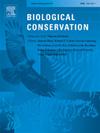自然遮阳有助于但不足以缓解热带南海绿海龟巢穴的变暖现象
IF 4.9
1区 环境科学与生态学
Q1 BIODIVERSITY CONSERVATION
引用次数: 0
摘要
在过去十年中,降低海龟巢穴温度被认为是减轻全球变暖影响和平衡海龟种群性别比例的一种保护策略。然而,在当前气候变暖的情况下,为海龟巢穴遮阳的有效性尚未完全阐明,尤其是在热带栖息地。我们通过在中国南海太平岛进行高频率的日常野外调查,记录了筑巢海滩的环境条件,并评估了自然遮阳对绿海龟(Chelonia mydas)离群温度和孵化幼体的影响。整个孵化期平均分为三个窗口,即第一、中间和最后一个窗口,并探索了低、中、高三个日照水平。结果表明,在高日照和低日照条件下,自然遮光可使孵出卵的比例从42.86%增加到66.67%,同时卵温从31.94 ± 2.02 °C降低到30.38 ± 1.72 °C。然而,遮光对提高孵化率和出壳率没有影响,在孵化中期作为性别鉴定期,孵化温度仍超过通常的关键值(29 °C),平均温度为 31.53 ± 1.97 °C,这导致该岛和该海域的绿海龟可能雌性化。在低日照条件下,孵化出的幼龟出现异常的概率最低(9.68 %),这些异常的可能性与孵化温度密切相关,尤其是在孵化窗口的第一和中间阶段。畸形等严重畸形会随着自我纠正反应而减弱。这些研究结果表明,在目前的气候条件下,仅靠自然遮阳不足以降低温度,从而缓解热带栖息地绿海龟雌性偏多的性别比例,并表明有必要对筑巢栖息地进行现场监测和调查,以制定更适当的海龟区域保护战略。本文章由计算机程序翻译,如有差异,请以英文原文为准。
Natural shading is helpful but not sufficient for mitigating warming in green sea turtle nests in the tropical South China Sea
Over the past decade, lowering nest temperatures has been identified as a conservation strategy for mitigating the effects of global warming and for balancing the sex ratios in sea turtle populations. However, the effectiveness of shading sea turtle nests under the current warming climate has not been fully elucidated, especially in tropical habitats. We recorded environmental conditions of nesting beaches and evaluated the effects of natural shading on clutch temperatures and hatchlings of the green sea turtle Chelonia mydas through high-frequency daily field surveys on Taiping Island in the South China Sea. The entire incubation period equally divided into three windows, first, middle and last, and three levels of sun exposure, low, medium and high, were explored. Natural shading was related to an increased proportion of hatched clutches from 42.86 % to 66.67 % under high and low sun exposure, respectively, accompanied by a reduction in clutch temperature from 31.94 ± 2.02 °C to 30.38 ± 1.72 °C. Nevertheless, shading had no effect on increasing hatch and emergence rates, and incubation temperatures still exceeded the usual pivotal value (29 °C) during the middle incubation window as the sex determination period by a mean temperature of 31.53 ± 1.97 °C, which resulted in potential feminization of green sea turtles on the island and in this sea area. The probability of hatchling abnormalities was the lowest (9.68 %) under low sun exposure, and the likelihood of these abnormalities was strongly correlated with clutch temperatures, particularly during the first and middle incubation windows. Severe abnormalities, such as deformities, weakened as self-righting responses. These findings reveal that natural shading alone is insufficient to lower temperatures to mitigate female-biased sex ratios in green sea turtles in tropical habitats under the current climate and indicate that in situ monitoring and investigations of nesting habitats are necessary for establishing more appropriate regional conservation strategies for sea turtles.
求助全文
通过发布文献求助,成功后即可免费获取论文全文。
去求助
来源期刊

Biological Conservation
环境科学-环境科学
CiteScore
10.20
自引率
3.40%
发文量
295
审稿时长
61 days
期刊介绍:
Biological Conservation is an international leading journal in the discipline of conservation biology. The journal publishes articles spanning a diverse range of fields that contribute to the biological, sociological, and economic dimensions of conservation and natural resource management. The primary aim of Biological Conservation is the publication of high-quality papers that advance the science and practice of conservation, or which demonstrate the application of conservation principles for natural resource management and policy. Therefore it will be of interest to a broad international readership.
 求助内容:
求助内容: 应助结果提醒方式:
应助结果提醒方式:


